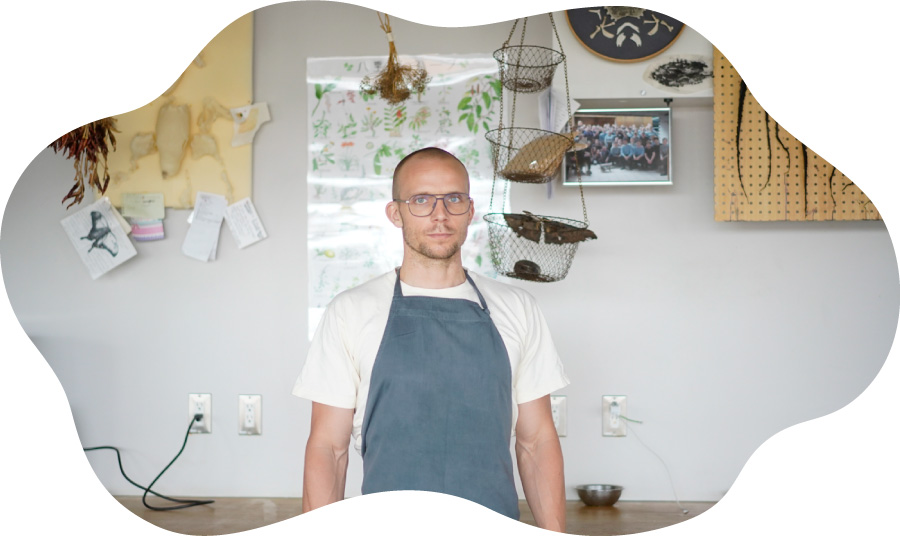

Mr. Thomas
Welcome to our test kitchen! This kitchen is located on a different floor than the space where our customers dine, and it is where we prepare test dishes for developing the restaurant menu, as well as stock fermented foodstuffs.


It could possibly be said that we enzymes also exist and function in all living things.





Mr. Thomas
Today’s theme is fermentation and enzymes, isn’t it? Since you’ve come all the way here today, why don’t you sample a dish?
What I’m holding in my hand right now is dough made with udon noodle flour. After sprinkling yeast cells over the top, we left the dough to ferment at a low temperature for two days. The yeast cells are growing on the dough. See, the dough is very soft and fluffy.


Mr. Thomas
The dough is served not on a plate, but rather on a cloth. First of all, let’s top it with some fudge (a melted candy-like sauce). Fudge is usually very sweet, but this fudge is not—if anything, it has a somewhat salty flavor. It is made by reducing (boiling down) a mixture of miso bean paste, water, and butter, then adding aromatic fragrance using oil infused with the aroma of blackcurrant wood. We top the fudge with a little caviar, then pour some hazelnut oil over the cavier.
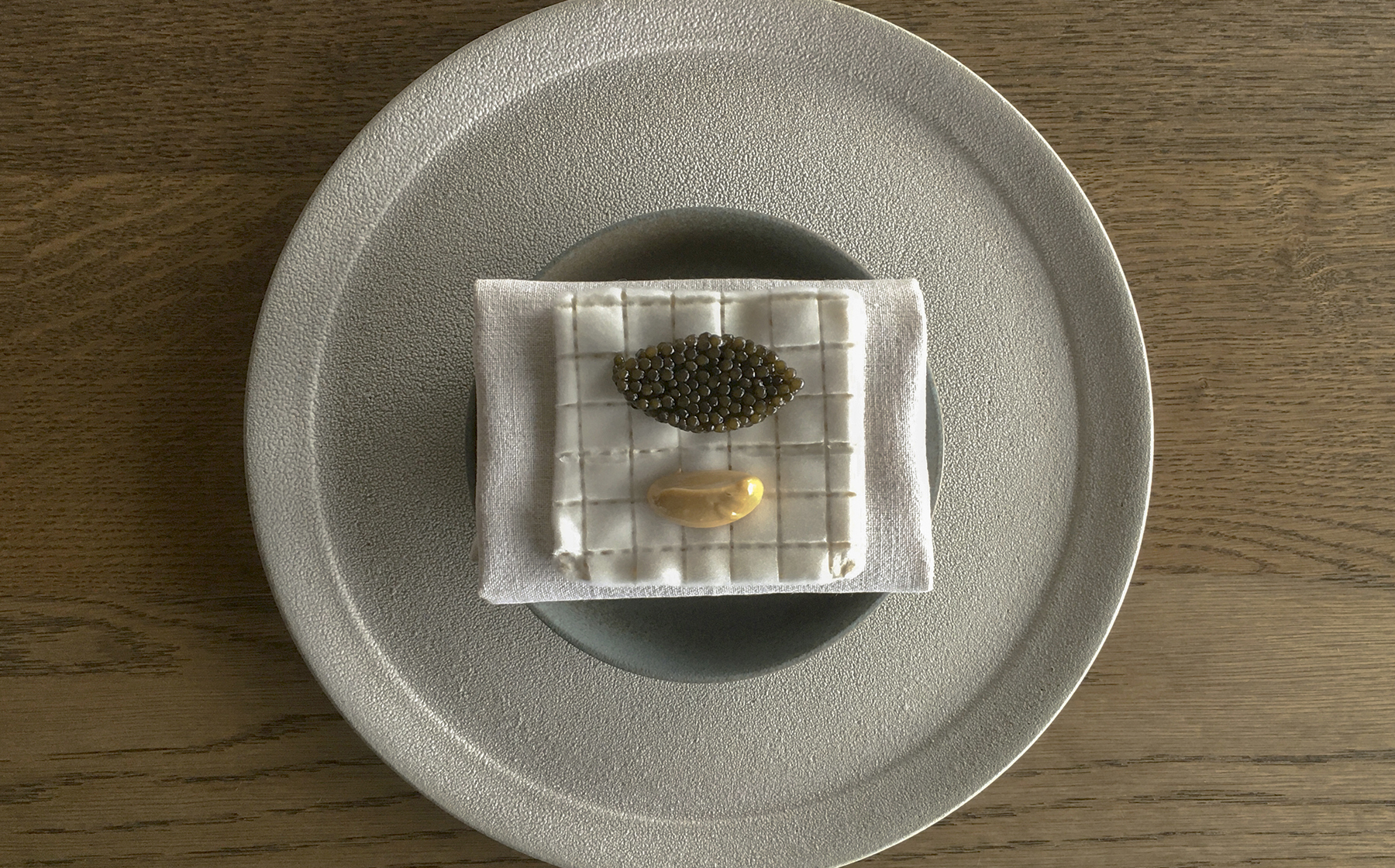

ー
Serving the dough on cloth is a unique idea! Apart from the visual expression, what other effects does that achieve, I wonder?
Mr. Thomas
he objective is more to enable you to enjoy how you are eating the dish than to create an impactful appearance. Take hold of both ends of the cloth to lift the dough, fold it slightly, then carry the dough to your mouth with your hands to eat as is. What do you think?
ー
Your mouth fills with the fragrant aroma…. The fudge has a creamy taste that melts immediately. The mild saltiness of the caviar and the oil both match the fudge perfectly. And the udon flour dough has such a fascinating softness! When you bite into it, the dough pushes back with a delicate elasticity like sticky mochi rice cakes, and it has a faintly sweet taste. This is the first time I’ve experienced such a tactile sensation when eating! It was delicious…. What is the name of this dish?
Mr. Thomas
The names given to dishes when we serve them to customers differ from the names that we use in the kitchen. In the kitchen, we call this dish as the Pillow.
ー
How was this idea originally born?
Mr. Thomas
At INUA, we have a chef who is Italian, and the idea came about after we were talking about the possibility of scattering yeast cells over pasta. We were not anticipating any specific result; rather, since we knew that yeast has the property of readily growing on starch, we thought that we would try doing that with pasta, which contains starch. We tried various combinations, but we had the most success with the udon flour dough.
ー
So you carry out experiments repeatedly?
In Japan, there is a type of somen noodle known as hinemono, which is aged using mold on the surface of the noodles. This apparently enhances the elasticity of the noodles. Did you know about this, Mr. Frebel?
Mr. Thomas
No, I’ve never heard of that. I would definitely like to give it a try!
ー
Growing mold on the surface and removing moisture is the same method used to produce bonito flakes.
Mr. Thomas
Speaking of bonito flakes, I have something that I would like to show you. There is a bonito flake manufacturer in Makurazaki City in Kagoshima City who has been very kind to me, and together we make various vegetable flakes. This was made from pumpkins. Appearance-wise, they don’t look as refined as bonito flakes though.
The molds that are propagated on the surface of the bonito are Aspergillus repens and Aspergillus glaucus. The mold is removed and the bonito dried, and then the same process is repeated over a period of several months to age the bonito, ultimately producing dried bonito flakes.
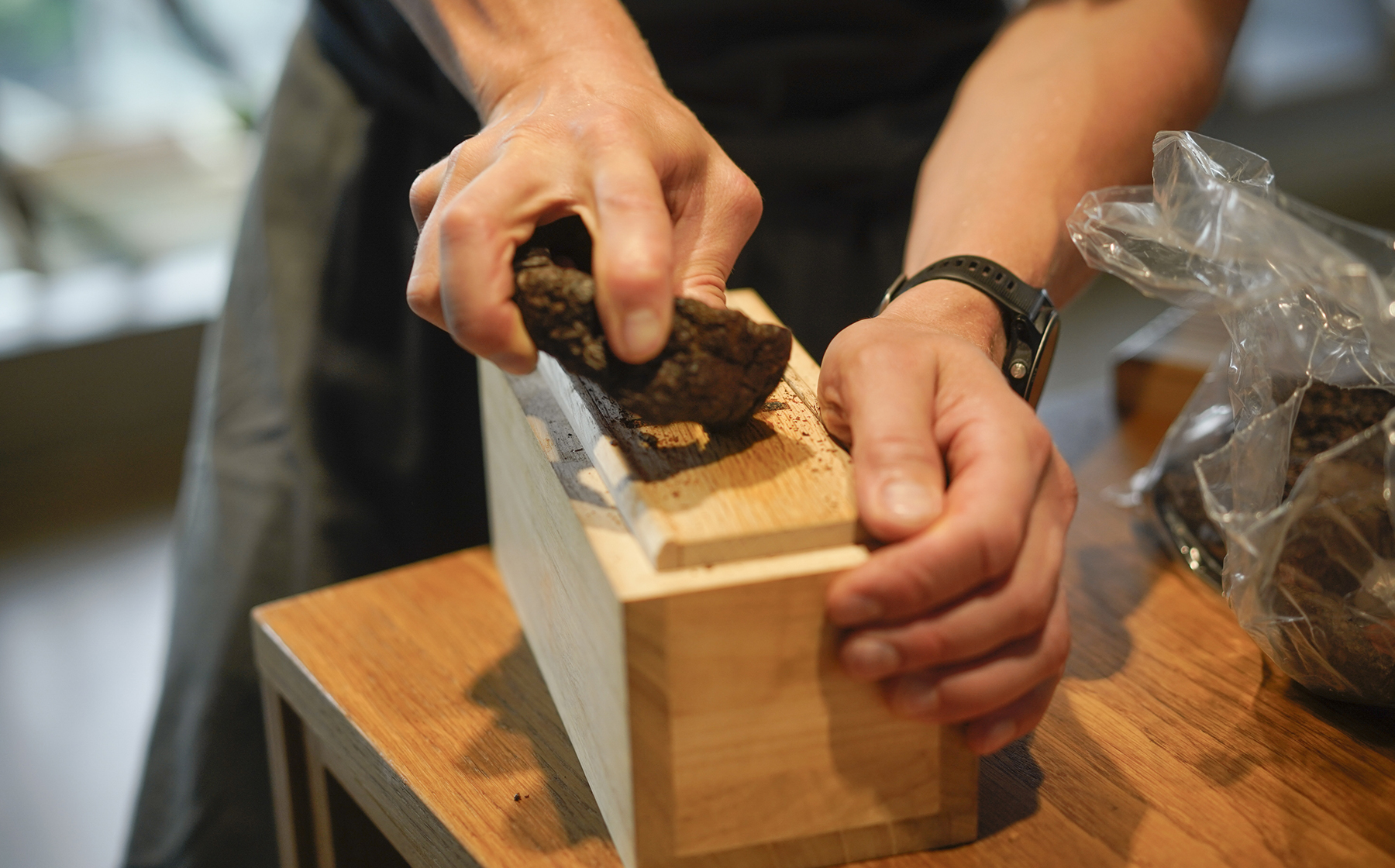

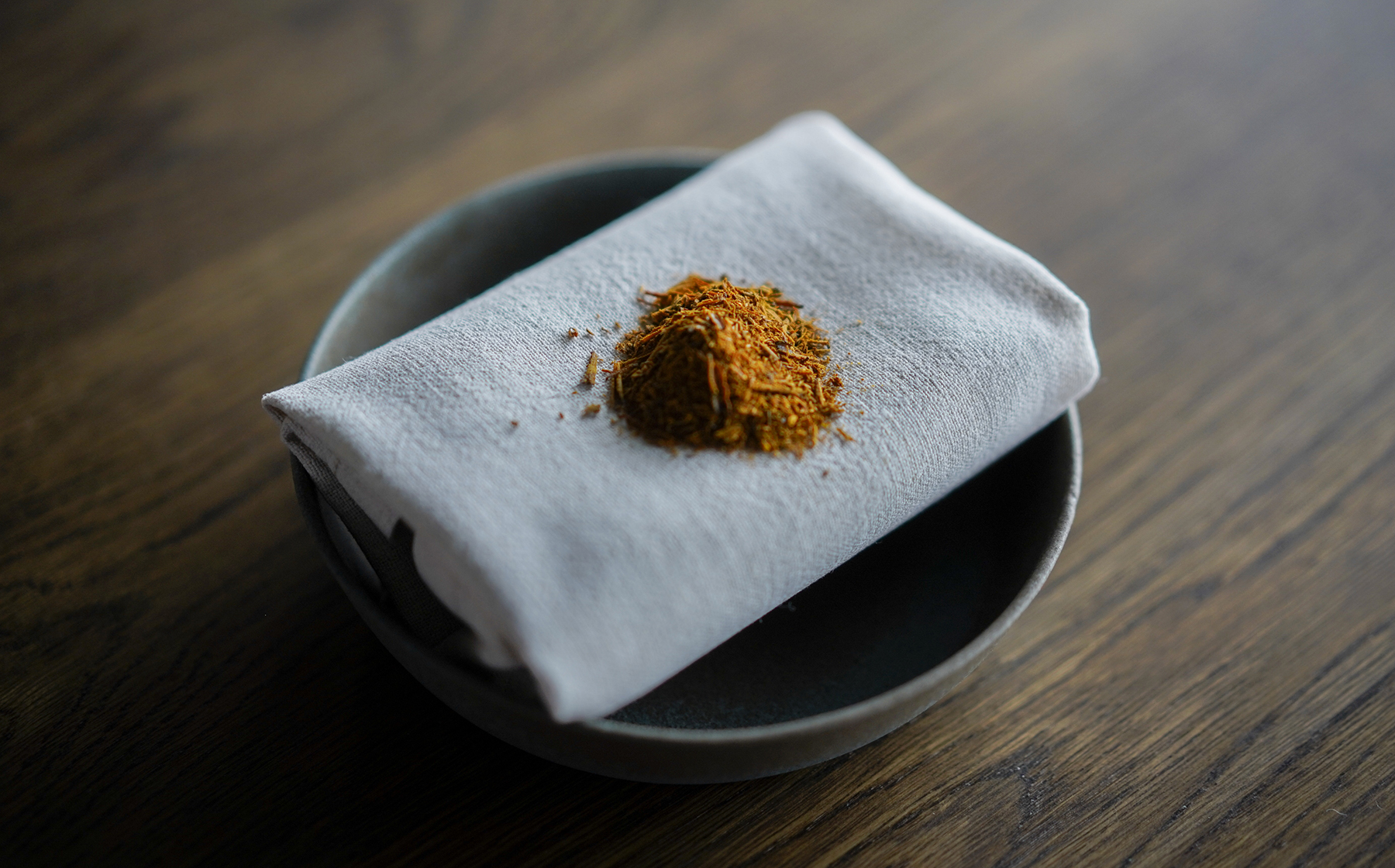

ー
Presumably you cannot serve Japanese-style dishes containing broth made with bonito flakes to vegan guests, so do you use these vegetable flakes instead in such situations?
Mr. Thomas
Yes, we do. Actually, I myself am a passionate vegetarian.
ー
As with the bonito flake production method we were just talking about, I understand that INUA has a Sourcing Team that specializes is searching for food ingredients across Japan. What is the role of this team?
Mr. Thomas
We refer to it as the Procurement Team; they are responsible for procuring food ingredients. It is essential that appropriate amounts of ingredients for menu items served in the restaurant are delivered at the appropriate time.


Mr. Thomas
Because Japan stretches north and south, the seasons change in order. For this reason, the period for which food ingredients are in season is also limited for each production area. The Procurement Team plays an important role in being sensitive to the changing seasons and adjusting suppliers with good timing so as not to miss ingredients when they are in season. While it is important for the team to go on research trips to develop new trading partners, it is also important that they build good relationships with our existing trading partners.
ー
Is the Procurement Team constantly traveling around Japan?
Mr. Thomas
Not just the Procurement Team—our chefs, including me, also take turns in traveling with the team to production areas to conduct research around 130 days per year. When I find an ingredient that we haven’t ever tried before in a book, I also sometimes ask the Procurement Team to search for that ingredient.
At Amano Enzyme, Inc., there is also a team of researchers known as Enzyme Hunters who search for enzymes with previously unknown actions. This team might be somewhat similar to your Procurement Team. They will even search for new enzymes as requested when someone says, “Wouldn’t it be great if there was an enzyme that did this?!”
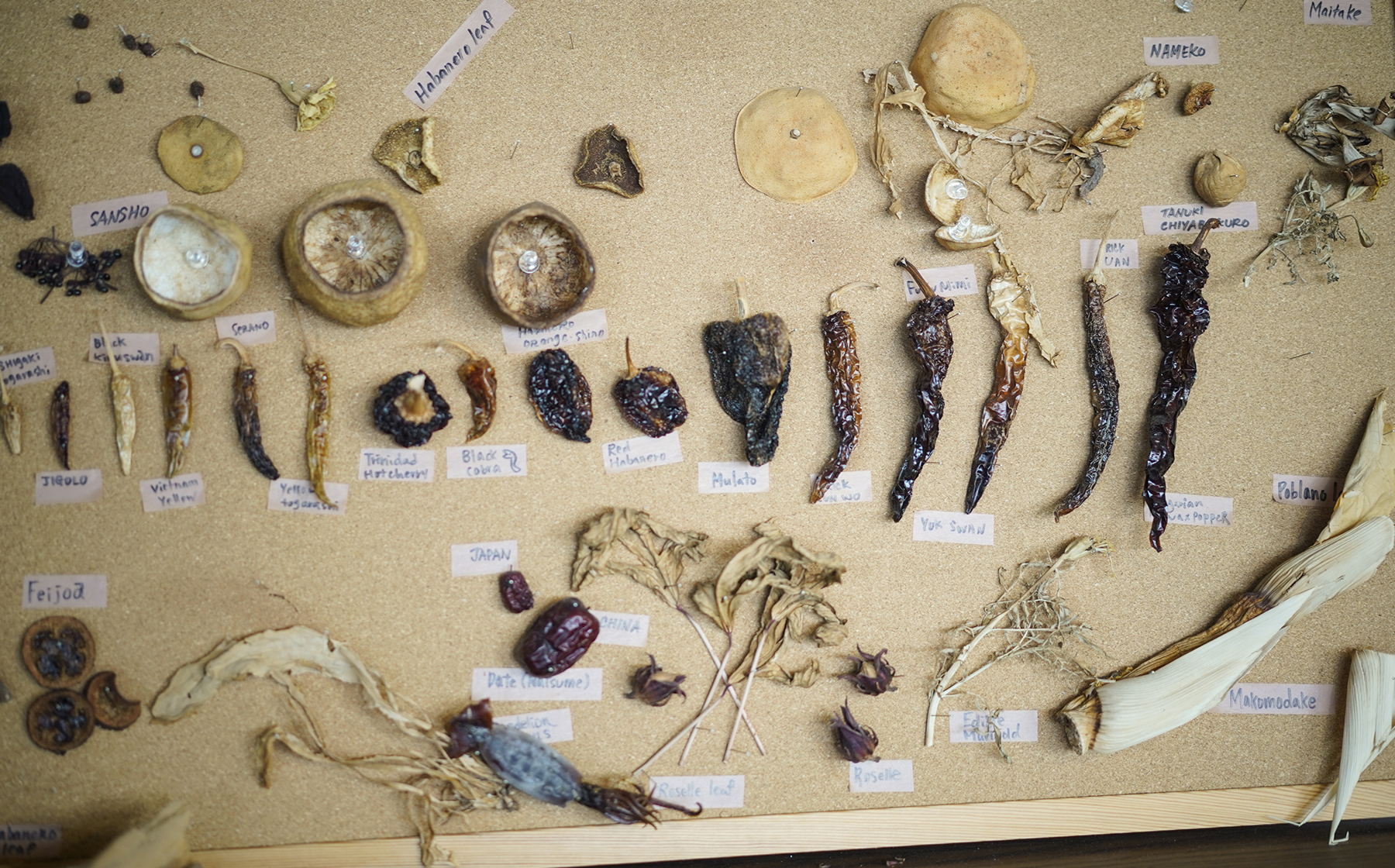

ー
Mr. Frebel, you were born in Germany and have traveled to Denmark and various other countries. Compared to other countries, how do you find the climate and food culture in Japan?
Mr. Thomas
I think that Japan is characterized by diversity. The climate ranges from subtropical climates, such as Okinawa, in the south to near-Arctic climates, such as Hokkaido, in the north. In terms of topography as well, there are mountains, rivers, plains, and ocean coastlines and lakeshores—there really is tremendous variety.
Japan’s nature is truly diverse, not only on land, but also in the ocean waters. There are so many different varieties of seaweed and marine creatures, I feel as if another, completely different, country exists there. A soup that we previously served at the restaurant, Seaweed and Sweet Shrimp, contained 14 different varieties of seaweed.
Until recently there weren’t any fermented foods using seaweed, but now soy sauce made from seaweed is being produced. Through the actions of yeast-producing enzymes amylase, protease, and mannanase, a grain-allergen-free soy sauce has been developed.
ー
Is seaweed eaten in Europe?
Mr. Thomas
Yes, seaweed is eaten in some parts of Europe, and there are many companies that are searching for ways to utilize seaweed. However, compared with Japan, there are only a few seaweed varieties. I think that the high interest in and fascination with food and flavor shown by people in Japan is unique in the world.
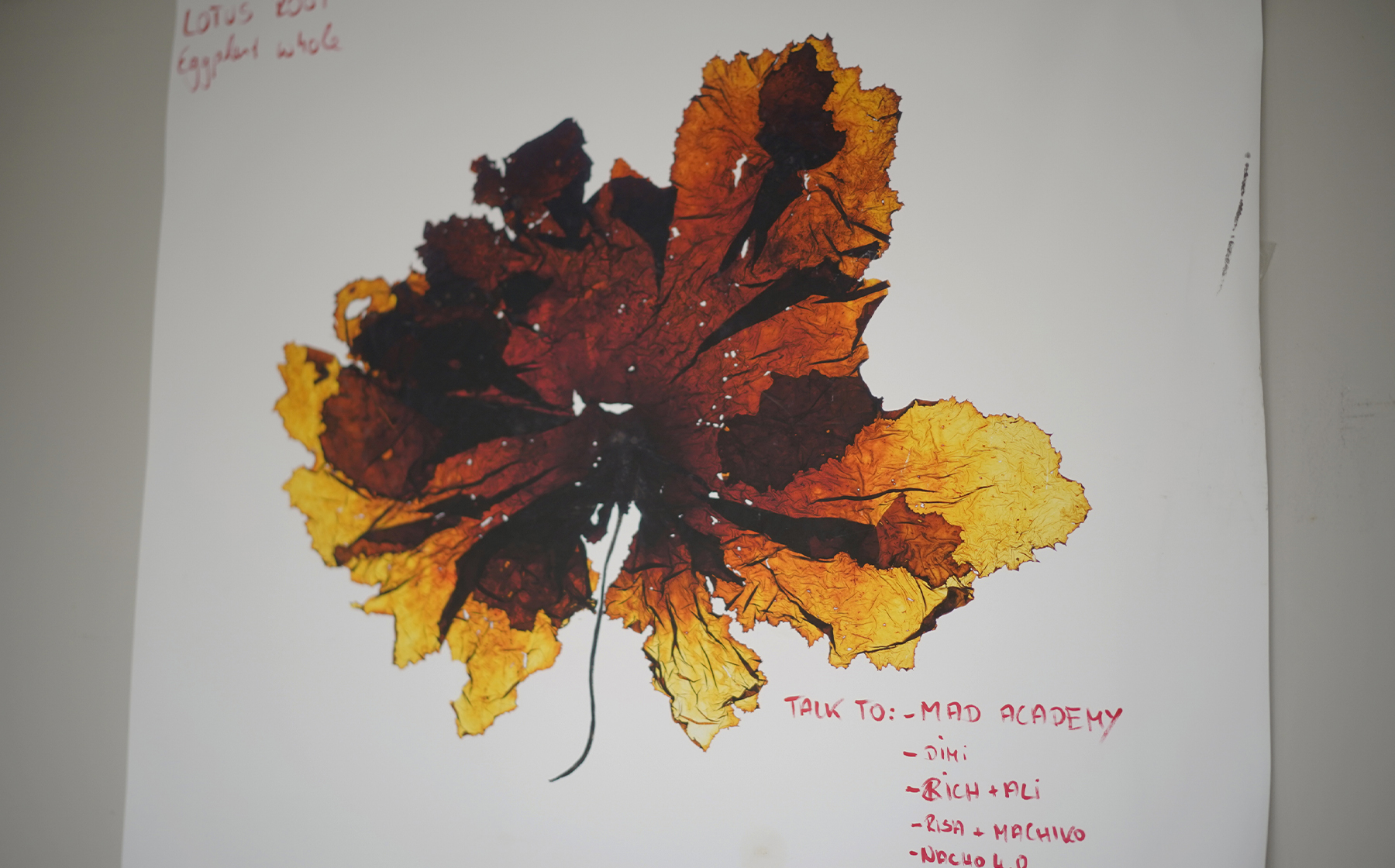

ー
What are your impressions about Japanese cooking techniques, food processing, and other techniques?
Mr. Thomas
I think that there is tremendous diversity, of course, and that all these techniques are consummate. Japanese people have a history of creating various cooking methods and devoting their lives to perfecting a single technique. They strive to create a food culture or food environment that is hailed as “No. 1 in Japan.”
In Japan, there are always people who are known as a professional, or a master, in a certain cooking field. For example, sushi chefs truly master this one specific food preparation method. This does not apply to only Japanese cuisine. For example, there are restaurants in Tokyo where you can eat Italian cuisine that is said to taste even more delicious than the food eaten in Italy. I think that is simply the kind of country Japan is.


Mr. Thomas
For example, don’t you agree that there are chefs in Japan who have focused single-mindedly on the one element of the fluffiness (softness and lightness) of dishes to truly create perfection?
The sense of fluffiness in dishes that Japanese chefs pursue—some of the varieties of enzymes used in the world of food are particularly adept at producing this sought-after fluffiness.
Continues to Part 2: What is Mr. Frebel’s idea of the ideal cuisine? And what are his dreams for the future? He also shows us some devices for manipulating enzymes!
I want to recreate the workings of nature in a single dish.Part2Enzymes are active in every aspect of our world, and we are seeking new possibilities for them.
In this corner, we visit people who are currently active in various fields with "Enzo" and ask them about their stories.

